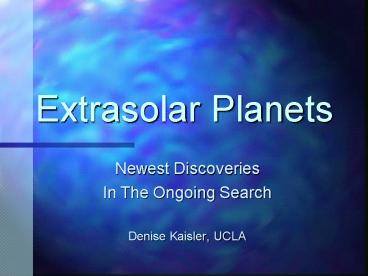Extrasolar Planets - PowerPoint PPT Presentation
1 / 31
Title:
Extrasolar Planets
Description:
What Gets A 'Planet' Label? ... A planet orbiting the lensing star will leave a special signature in the light profile. ... study of the interference of light waves ... – PowerPoint PPT presentation
Number of Views:121
Avg rating:3.0/5.0
Title: Extrasolar Planets
1
Extrasolar Planets
- Newest Discoveries
- In The Ongoing Search
- Denise Kaisler, UCLA
2
Overview
- Definition of Planets
- Why We Search
- Current Search Techniques
- Newest Discoveries
- Cutting-Edge Search Technologies
- Future Space Missions
3
Why We Search
- to discover new horizons
- to get around the dangerous problem of using a
single example to create a theory - to cure cosmic loneliness
4
What Gets A Planet Label?
- Mass - less than 10 times the mass of Jupiter
(the deuterium fusion limit) - Formation - built up from particles in a dusty
disk, not condensed from a gas cloud like a star
or a brown dwarf - Type - terrestrial or Jovian
5
Planet Search Techniques
- Pulsar timing
- Radial Velocity Measurements
- Astrometry
- Photometry
- Gravitational Microlensing
- Adaptive Optics
- Interferometry
6
Pulsar Timing
- Pulsars are old, collapsed stars that spin up to
several thousand times a second. They send out
beams of radiation along their magnetic axes. As
a beam sweeps by us, we see a pulse of light, as
if the Earth was a ship floating near a
lighthouse. - Usually, the beat of a pulsar is extremely
regular.
7
- If the beats of a pulsar are bunched up at one
point and more widely spaced at another time, we
conclude that there is another body pulling the
pulsar back and forth. - The first extrasolar planets ever found were
detected this way. - In 1991, astronomers detected 3 planets orbiting
a pulsar in Virgo. Each planet is thought to be
about the size of the Earth.
8
(No Transcript)
9
Radial Velocity Measurements
10
(No Transcript)
11
(No Transcript)
12
Astrometry
- Definition measures the position of a star
against the sky (the proper motion) - Basic Idea low-mass companions will cause a
wiggle in a stars path - possible to obtain more information than by
observing the radial velocity - requires high-precision observations
13
(No Transcript)
14
Photometry
- Definition measures the brightness of a star.
- Basic Idea look for variations in a stars
brightness caused by transiting planets - make sure the orbital plane is oriented correctly
- Bad News requires precision of 1 part in 100 000
and lots of time. - Good News we can actually do this with current
technology - Better News some astronomers are doing it right
now.
15
Gravitational Microlensing
- Basic Idea A star passing in front of a more
distant object will act as a lens. - A planet orbiting the lensing star will leave a
special signature in the light profile.
16
(No Transcript)
17
(No Transcript)
18
Latest Findings
- there are 20 known exoplanets
- most are massive and close to their parent star
(but this is a selection effect) - so far, we have found planets orbiting
3 of surveyed stars. - more sensitive searches are planned for the future
19
(No Transcript)
20
Where No PlanetHas Gone Before
- some exoplanets have remarkably short orbital
periods - - How could a Jovian planet form so close to its
parent star? - - Do such planets migrate inwards early in their
lifetimes ?
21
Eccentric Or Just Crazy?
22
New QuestionsSpawn New Theories
- The Pushy Disk
- Forces from the protoplanetary disk cause a
planet to move towards its host star. - Problems
- What stops the planet from crashing into the
star? - This theory doesnt readily explain the observed
high eccentricities.
- Jupiter Wars
- A Jovian planet can eject planetesimals moving on
similar orbital tracks. - Problem
- A migrating planet would have to shift its own
mass in planetesimals to move the required
distance (about 5 AU).
23
A System Of Giant Planets
- Astronomers Geoff Marcy and Paul Butler of SFSU
have found a system of three Jupiter-mass planets
orbiting the nearby star Upsilon Andromedae. - Terrestrial planets may also exist.
- This discovery represents the second known
planetary system .
24
Cutting-Edge Search Techniques
- Until now, nobody has actually seen any
extrasolar planets - All known planets were discovered by using
indirect methods. - Adaptive Optics and Interferometry are our two
great hopes for the future.
25
Adaptive Optics
- Movements of the Earths atmosphere cause stars
to twinkle. - This seeing is due to pockets of air with
various densities moving across the star and
bending the incoming light in different
directions. - Adaptive optics seeks to correct seeing by
straightening out the incoming light waves
26
(No Transcript)
27
Interferometry
- study of the interference of light waves
- combines the signals from two or more widely
separated telescopes - achieves higher resolution than images from a
single telescope - nulling capability
- several missions planned for the near future
28
Deep Space 3
- a.k.a. Space Technology 3 or the New Millennium
Interferometer - an optical instrument consisting of three
satellites in a heliocentric orbit - two 12 cm
reflectors and one combiner - due to be launched in 2001.
29
Space Interferometry Mission
- Space Interferometry Mission (SIM) will be a
single satellite, rather than a set of three. It
will have twin telescopes spaced 10m apart to do
very precise astrometry and measure the
parallaxes of faint stars. The data from this
mission will be even more precise than the
results from the Hipparcos satellite. It is due
to be launched in 2005
30
Next Generation SpaceTelescope
31
Terrestrial Planet Finder

